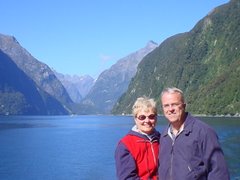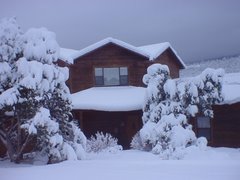Savannah – Day 2
Friday, Nov. 2, we started off with a 2.5 hr. Savannah Experience tour. Our driver/guide was a historian named Jefferson Hall (named after a building or a president?) who had worked for the Georgia Historical Society and done Savannah research, so he knew lots of facts and figures. He could quote extensively by memory from journals and reports. He could do voices and dialects. The tour covered not only the historic district, but adjoining districts. These included Victorian and stately, elegant early 20th century neighborhoods, and three or four traditionally black neighborhoods.
Friday, Nov. 2, we started off with a 2.5 hr. Savannah Experience tour. Our driver/guide was a historian named Jefferson Hall (named after a building or a president?) who had worked for the Georgia Historical Society and done Savannah research, so he knew lots of facts and figures. He could quote extensively by memory from journals and reports. He could do voices and dialects. The tour covered not only the historic district, but adjoining districts. These included Victorian and stately, elegant early 20th century neighborhoods, and three or four traditionally black neighborhoods.

(We didn't stop for pictures anywhere, and couldn't shoot through bus windows, but I'm going to insert a few taken at other times, just to give you the Savannah experience.)
Savannah is very much on a restoration wave, both publicly and privately funded, and we saw many examples of this work. Restoration and preservation work started in the 1950s and saved the historic district, and has since grown and spread substantially, especially to the historically black neighborhoods. We got the feeling that Hall’s research had focused on the black districts because he knew a lot about the different cultures (e.g., African vs. Caribbean) and leading figures within these groups.
Savannah is very much on a restoration wave, both publicly and privately funded, and we saw many examples of this work. Restoration and preservation work started in the 1950s and saved the historic district, and has since grown and spread substantially, especially to the historically black neighborhoods. We got the feeling that Hall’s research had focused on the black districts because he knew a lot about the different cultures (e.g., African vs. Caribbean) and leading figures within these groups.

One story he told us: He and some other history buffs went to SC to visit a former matriarch of one of Savannah’s black districts. She focused her gaze on him and said, I think I know you. Have we met? No, they hadn’t, but she continued to stare at him. She brought his face close to hers and said, Walter Cronkite (in Ethel Waters’ voice)! Bingo: The guide’s father is Bruce Hall, long time CBS newsman who often reported on Walter’s show. The son had a good broadcast voice.
We thought later we should have asked Mr. Hall why he chose to become a tour guide, doing the same tour twice a day, five days a week, when he could have been doing real history work. Well, maybe that’s the answer. Sharing Savannah history, particularly the part that tends to be overlooked, with hundreds of people is more of a service than researching it. And you meet so many interesting people!
We thought later we should have asked Mr. Hall why he chose to become a tour guide, doing the same tour twice a day, five days a week, when he could have been doing real history work. Well, maybe that’s the answer. Sharing Savannah history, particularly the part that tends to be overlooked, with hundreds of people is more of a service than researching it. And you meet so many interesting people!

Some facts. Georgia was the 13th of the original colonies, coming in, I believe, some sixty years after the 12th (don’t have internet access to look it up). Oglethorpe and the colony’s English administrators established the colony as a haven for the poor and indigent – not quite a penal colony, but peopled by folks from society’s lower rungs. Free passage was provided.
The Georgia Trust Commission, who tried to run things from England, consisted of reformers and they set a few idealistic rules. These included: No hard liquor. No slavery. No Papists. No lawyers. Such rules did not set well with the colonists and traders and did not last long – repealed in 20 years. Our guide indicated, though, that Georgia came relatively late to the African slave trade. Also, there were a substantial number of African-Americans in Georgia pre-emancipation who were not slaves – peaking at 20% in 1810. Records show that some of them owned slaves.
Back to the colonists. Forty families were in the first boatload. The city was laid out with squares that sit astride the cross streets. Around each square were 40 housing lots. Additional squares and (rectangular) neighborhoods were added as Savannah grew. At first the squares were just meant to be open space (our guide called them negative space), but they later became the pocket parks that bejewel the city. There are now 22 or 23 depending on whether you count one that is now a large pit where the city is building an underground parking garage, to be covered, when completed, by a park.

The guide told Wesley’s story and filled in some gaps in the information I had gotten from the internet. He told me that Wesley is highly valued by historians for his journal – it tells not just his story but provides valuable information about the colony and its people, not available elsewhere. Some key people, such as Oglethorpe, did not leave a paper trail.
When we visit new cities we like to get an overview via bus tours. We hit a good one here that provided much depth also.
Tybee Island, about 15 miles east of Savannah, is Savannah’s beach. We went out there for a glimpse of the ocean and lunch at the Crab Shack (Savannah's, not Joe’s). Nice, funky sort of place – given to clever signs such as: We’d like to give you the shirt off our back, but we’d rather you buy a clean one in our gift shop.


Then, back to town, primarily to visit Chippewa Square. Forest Gump was sitting on a bench in this square at the beginning of the movie – while a feather drifted down, wafting around this (freshly repainted, I found out) church steeple. Jeff Easterling’s a big Gump fan, so this was for him.

(Incidentally, Woodrow Wilson was married in this church - a Presbyterian Church.)
Here’s where the Gump bench was – a movie prop, not a fixture here.

Finished the day, as planned, with allyoucaneatcatfish. Another very good day in Savannah.
Cheers
Cheers
Rob and Susie







No comments:
Post a Comment